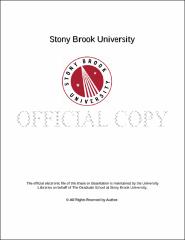| dc.identifier.uri | http://hdl.handle.net/11401/77140 | |
| dc.description.sponsorship | This work is sponsored by the Stony Brook University Graduate School in compliance with the requirements for completion of degree. | en_US |
| dc.format | Monograph | |
| dc.format.medium | Electronic Resource | en_US |
| dc.language.iso | en_US | |
| dc.publisher | The Graduate School, Stony Brook University: Stony Brook, NY. | |
| dc.type | Dissertation | |
| dcterms.abstract | Adenoviral (Ad) vectors have significant potential as gene delivery agents, oncolytic agents and vaccine scaffolds. Despite extensive effort, adenoviruses have not yet realized this potential. Primarily, this is a result of immune responses to the introduced vectors and our inability to efficiently target therapeutically relevant tissues. Considerable resources have been directed at addressing these limitations; however progress is still hampered by the drawbacks of current virus engineering approaches. In this context, our group reported a novel chemoselective method for modification of Ad vectors using bioorthogonal unnatural sugars and/or unnatural amino acids. With the aim of expanding Ad tropism to diverse cancer cells, we developed various effective cancer-targeting Ad vectors via metabolic labeling and bioorthogonal " click" chemistry. That is, in order to prepare " clickable" targeting ligands, the alkyne moiety was covalently linked with different synthetic peptides or affibody proteins which have specific affinities to the corresponding receptors overexpressed on an array of cancer cells. Then, the " click" reaction was performed between alkyne-peptides (or alkyne-proteins) and azide-enabled Ad vectors containing a reporter transgene. Targeting studies indicate substantial (~1000 fold) to modest (~3 fold) increases in infectivity dependent of both the nature of the cell line and the method of virus modification. To wit, significantly increased gene deliveries were observed in the cells expressing target receptors with higher density and with the Ad vectors modified via copper-catalyzed " click" reaction, compared with the cases of lower-receptor density and strain-promoted " click" reaction. Interestingly, cyclic-RGD-peptide-conjugated Ad showed unexpected lower transduction efficiencies in mouse melanoma cells than linear-RGD-Ad whose ligand has lower affinity to the target receptor (alpha v beta3 integrin) than cyclic RGD peptide. Focusing on the selective role of homologous alpha v beta5 integrin which promotes Ad-mediated membrane permeabilization and subsequent endosome rupture, we hypothesized that this unexpected low transductions was due to alpha v beta5-excluded endocytosis" caused by the higher binding specificity of cyclic RGD peptide to alpha v beta3 integrin than alpha v beta5 particularly in the cells expressing alpha v beta3 integrin predominantly over alpha v beta5, which was supported by our thin-sectioning TEM study. Lastly, for the purpose of extending our approach to in vivo studies, we attempted to conjugate a panel of ligands to label positron emitters such as 18F, 64Cu, 68Ga, and 89Zr onto viral capsid via " click" chemistry. In this context, cancer-targeting-folate- and 89Zr-labeling-DFO- moieties were conjugated onto Ad capsid via Staudinger ligation and subsequent copper-catalyzed [3+2] azide-alkyne cycloaddition, which demonstrated promising 100% radiolabeling yield. | |
| dcterms.available | 2017-09-20T16:52:04Z | |
| dcterms.contributor | Raleigh, Daniel | en_US |
| dcterms.contributor | Carrico, Isaac S | en_US |
| dcterms.contributor | Ojima, Iwao | en_US |
| dcterms.contributor | Hearing, Patrick. | en_US |
| dcterms.creator | Oum, Yoon Hyeun | |
| dcterms.dateAccepted | 2017-09-20T16:52:04Z | |
| dcterms.dateSubmitted | 2017-09-20T16:52:04Z | |
| dcterms.description | Department of Chemistry. | en_US |
| dcterms.extent | 237 pg. | en_US |
| dcterms.format | Monograph | |
| dcterms.format | Application/PDF | en_US |
| dcterms.identifier | http://hdl.handle.net/11401/77140 | |
| dcterms.issued | 2015-08-01 | |
| dcterms.language | en_US | |
| dcterms.provenance | Made available in DSpace on 2017-09-20T16:52:04Z (GMT). No. of bitstreams: 1
Oum_grad.sunysb_0771E_11252.pdf: 7909334 bytes, checksum: 9bdd945d9fb6e00013383fbbf5bc02ac (MD5)
Previous issue date: 2012 | en |
| dcterms.publisher | The Graduate School, Stony Brook University: Stony Brook, NY. | |
| dcterms.subject | Adenovirus, Bioorthogonal, Click reaction, Gene Therapy, Unnatural amino acid, Unnatural sugar | |
| dcterms.subject | Chemistry | |
| dcterms.title | Modification of Adenoviral Tropism to Cancer Cells via Metabolic Labeling of Unnatural Sugars and/or Unnatural Amino acids and Subsequent Bioorthogonal Conjugations | |
| dcterms.type | Dissertation | |

